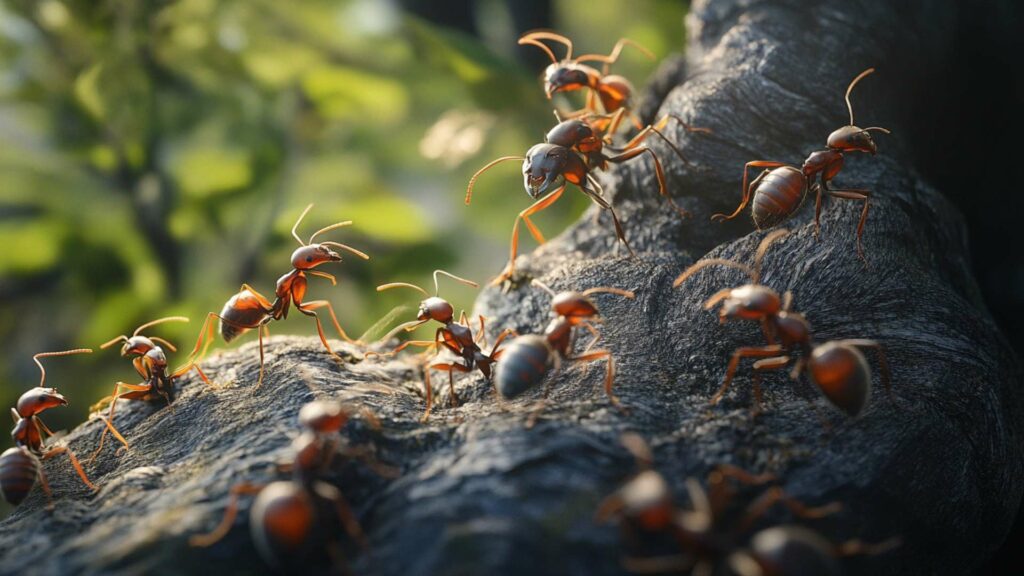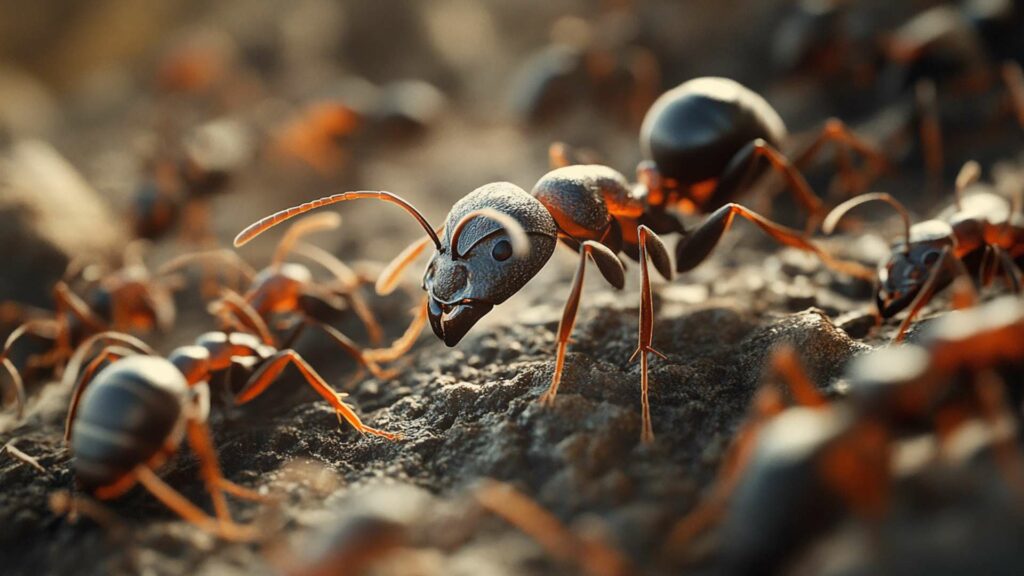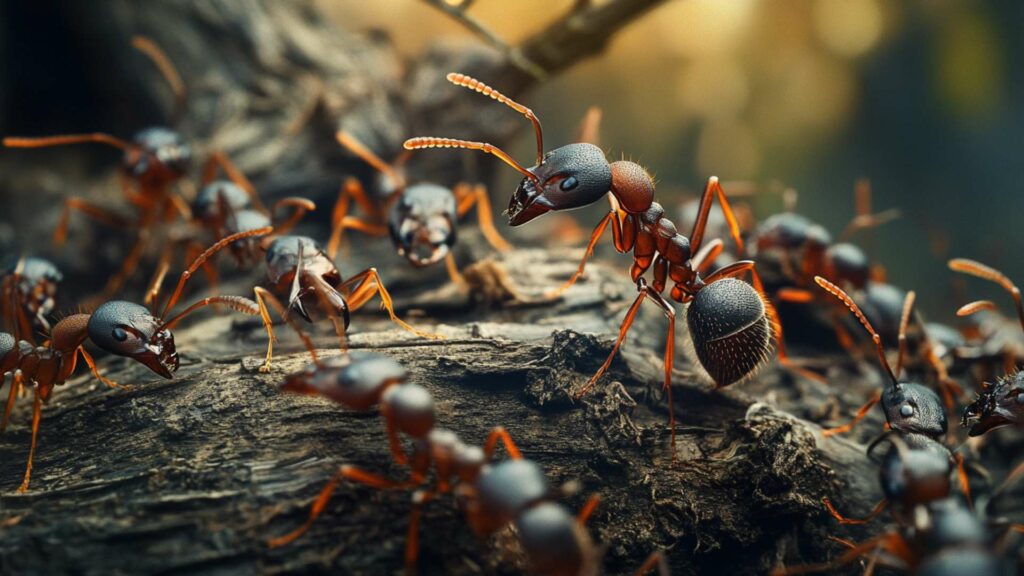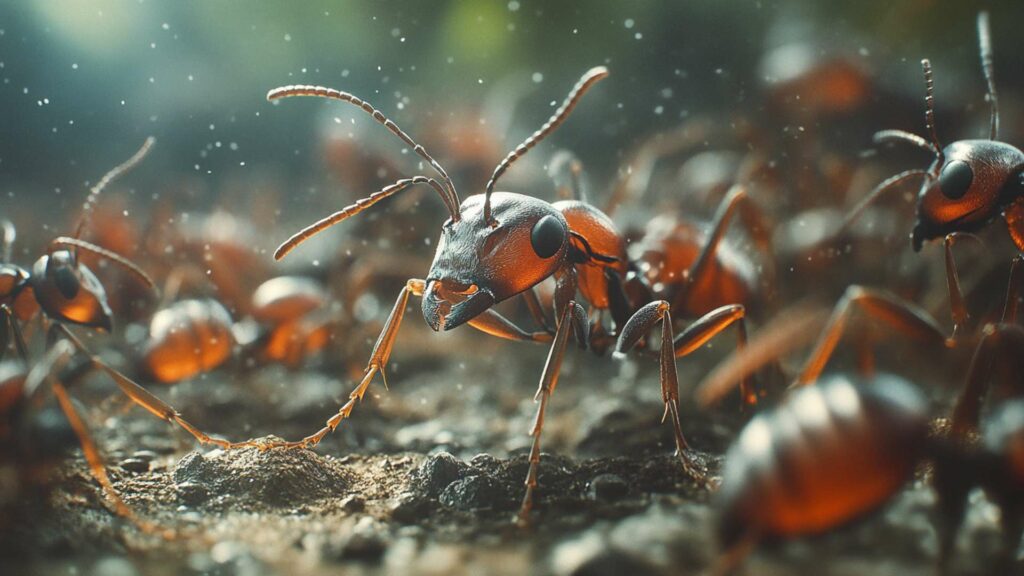Ants, those tiny creatures that scurry across our paths seemingly unnoticed, have long captivated the imaginations of both scientists and everyday observers. Their strength relative to their size has been a subject of fascination for centuries. From ancient fables depicting ants as diligent workers to modern-day studies conducted by renowned ant biologist Fred Larabee at Urbana-Champaign, we are continually amazed by these small wonders of nature.
A World of Wonders

The world of ants is vast and diverse, with over 12,000 known species. Each species possesses its own unique anatomical and physiological traits that contribute to their impressive strength capabilities.
While some ants may be capable of lifting objects many times their own body weight, others may have more modest lifting abilities. The variation in ant species’ strength is an intriguing area for exploration.
Exploring the Question: How Much Can an Ant Lift?
Unraveling Nature’s Secrets
To understand how much an ant can lift, we must first delve into their natural history and examine the factors influencing their lifting capabilities. Size plays a crucial role; larger ants generally possess greater strength due to their increased muscle mass and leverage. However, it’s not just about individual capability; ants are social insects that often work together within large colonies to accomplish extraordinary tasks.
An Ant’s Weightlifting Feats
While it may seem implausible that such diminutive creatures as ants can lift and move objects significantly heavier than themselves, the truth is astonishing. Some remarkable instances include Azteca ants carrying objects up to 50 times their own body weight or being able to lift other insects several times heavier than themselves during hunting expeditions for food or defense against predators.
A Human Perspective
To put these feats into perspective, imagine if humans could lift objects equivalent to 1,000 times their own weight. The sheer strength of ants is a marvel that challenges our understanding of what is possible in the natural world.
Exploring the limits of ant lifting capacity opens up new avenues for scientific inquiry and provides insights into the incredible adaptability and potential of these miniature superheroes. In the next sections, we will delve deeper into ant anatomy and physiology, uncovering the secrets behind their impressive strength-to-size ratio.
We will also explore how ants work collectively within large colonies, to achieve monumental tasks. Prepare to be amazed as we embark on a journey into the extraordinary world of ants and their remarkable lifting capabilities.
Overview of an Ant’s Body Structure
Ants, those tiny creatures that scuttle around our homes and gardens, possess a surprisingly complex and intricate body structure. To better understand how much they can lift, we must delve into the world of an ant’s anatomy. An average ant consists of three main body segments: the head, thorax, and abdomen.
The head houses important sensory organs like antennae and compound eyes – essential for navigation and communication within their bustling colonies nest. The thorax connects the head to the abdomen and is crucial for locomotion, as it contains six legs that enable ants to scurry swiftly across different terrains.
Muscular System and its Role in Lifting Capabilities
The muscular system of ants is remarkably developed considering their diminutive size. Like other insects, ants have two types of muscles: striated muscles responsible for rapid movements like walking or running, and smooth muscles controlling functions such as digestion. However, it is the powerful striated muscles that allow ants to carry heavy loads relative to their own body weight.
One notable anatomical adaptation aiding their lifting abilities is the presence of specialized attachment sites on their exoskeleton called apodemes. These apodemes serve as anchor points for muscle attachments, enabling ants to exert force efficiently while lifting objects.
Additionally, some species possess enlarged mandibles or jaws specifically adapted for lifting or transporting items back to their colonies. In fact, recent studies conducted by postdoctoral researcher Dr. Fred Larabee revealed that certain species like Azteca ants have evolved unique anatomical features further augmenting their strength capabilities.
By understanding these anatomical traits and physiological mechanisms at play in ant bodies, we can begin to unravel just how much weight these remarkable insects are truly capable of carrying.
Factors influencing an ant’s lifting capacity
Size and species variation among ants
Ants come in a multitude of sizes and species, each with its unique characteristics. From the tiny worker ants we encounter in our homes to the larger soldier ants found in the wild, their size plays a vital role in determining their lifting capacity. It’s important to note that not all ants are created equal when it comes to strength.
Some species of the strongest animals are naturally stronger than others due to variations in their anatomical and physiological traits. For example, certain species possess larger muscles or more robust exoskeletons, enabling them to lift heavier objects compared to their smaller counterparts.
Ants’ adaptation to their environment and lifestyle
To understand an ant’s lifting capacity fully, we must consider how they have adapted to their environment and lifestyle. Ants have evolved over millions of years, developing specialized features that aid them in carrying out various tasks efficiently.
For instance, some ants have neck muscles specifically designed for lifting heavy objects or defending against predators. These adaptations allow them to navigate through complex terrain while effortlessly hauling items back to their nests.
Additionally, an ant’s lifestyle influences its strength capabilities. Ant colonies require constant maintenance and expansion, which often involves moving heavy objects such as food sources or building materials for constructing intricate underground tunnels.
As a result, certain ant species have evolved with enhanced strength capacities that enable them to perform these demanding tasks effectively. The size and species variation among ants along with their adaptations play significant roles in determining an ant’s lifting capacity.
While some ants may be small yet surprisingly strong, others may not possess the same level of physical prowess due to differences in body size and physiological traits. Furthermore, adapting to specific environments and fulfilling various tasks within a colony also contributes heavily towards developing the strength necessary for an ant’s survival.
Determining an ant’s maximum lifting ability

Experimental methods used to measure lifting capacity
To unravel the mystery of how much weight these minuscule creatures can heave, researchers have devised clever experiments to test their strength. One method involves creating a controlled environment where ants are presented with various objects of known weights. By carefully observing the ants’ behavior and measuring their efforts, scientists can estimate their lifting capabilities.
This approach provides valuable insights into the resilience and adaptability of these remarkable insects. Another experimental technique entails using force sensors or tiny scales that detect the force exerted by an ant as it attempts to lift an object.
These devices are delicately calibrated to accurately measure even the tiniest forces, allowing scientists to obtain precise data on an ant’s lifting power. Such advanced technology enables researchers to analyze the strength exerted by different species of strong ants and understand how anatomical and physiological traits influence their abilities.
Average weight lifted by different ant species
The average weight lifted by ants varies greatly across different species. For instance, carpenter ants (Camponotus spp.) are renowned for their impressive strength, capable of carrying objects up to ten times their own body weight! In contrast, smaller species like pharaoh ants (Monomorium pharaonis) exhibit lower lifting capacities but compensate through their sheer numbers in a colony.
Interestingly, studies conducted at the Wisconsin-Madison University under the supervision of paleoanthropologist John Hawks revealed astounding findings regarding leaf-cutter ants (Atta spp.). The research observed that these industrious creatures can transport leaf fragments weighing over 50 times their own body weight over considerable distances!
These findings highlight not only the astonishing physical abilities of certain ant species but also shed light on potential strategies used by colonies in accomplishing laborious tasks. Experimental techniques coupled with meticulous observations have allowed scientists to gain a deeper understanding of how much weight ants can lift.
Through these methods, researchers have discovered that ants possess remarkable strength relative to their size, with lifting capacities varying among species. The incredible feats demonstrated by these tiny creatures challenge our perception of what is possible and inspire us to ponder the limitless potential hidden within the natural world.
Surprising Facts about Ants’ Strength-to-Size Ratio

Comparing an Ant’s Lifting Capacity to Its Own Body Weight
Ants might seem tiny, but their strength is nothing short of impressive. When it comes to lifting capacity, ants exhibit a remarkable strength-to-size ratio. These industrious creatures can carry objects many times heavier than their own minuscule bodies.
To put it into perspective, an average ant weighing just a few milligrams can easily lift objects that weigh up to 50 times its weight! This extraordinary feat showcases the astounding power hidden within these diminutive insects.
Mind-Boggling Examples of What Ants Can Carry Relative to Their Size
To truly appreciate the astonishing lifting ability of ants, let’s delve into some mind-boggling examples. Picture this: an ant carrying a load that weighs about half as much as itself – like a human effortlessly lifting and moving an object twice the times their body weight by weight! While this might sound incredible, it is a normal task for these exceptional creatures.
Some species have even been observed transporting materials up to 100 times their body weight! One fascinating example is the leaf-cutter ant, known for its ability to cut and carry large sections of leaves back to its colony.
These industrious ants can hoist leaf fragments weighing up to 50 times their own weight! Imagine a human being able to lift and transport enormous tree branches with ease – that would be equivalent in relative terms.
Another astonishing case involves weaver ants, capable of creating living bridges by linking themselves together using their bodies. This cooperative effort allows them to construct bridges long distances strong enough for entire colonies to traverse safely across gaps or rivers.
The combined strength of these small insects enables them to overcome obstacles far beyond what any individual could achieve alone. With such incredible feats accomplished by these tiny creatures, it’s no wonder they have captivated the imagination of researchers and onlookers alike.
Their strength-to-size ratio truly defies expectations and reminds us that remarkable abilities can be found in even the most seemingly insignificant of beings.
The Collective Power of Ant Colonies in Moving Objects

Cooperative Behavior within Colonies for Efficient Tasks
Ant colonies are incredible examples of teamwork and cooperation. Each ant has a specific role within the colony, and when it comes to moving objects, they work together seamlessly. Through chemical signals and tactile communication, ants coordinate their efforts to achieve common goals.
For instance, when an ant discovers a food source or a large object that needs to be moved, it releases a pheromone trail to guide other ants from its colony towards the task at hand. This allows many ants to quickly join forces and combine their strength to lift or transport larger objects that would otherwise be impossible for an individual ant.
Examples of Extraordinary Feats Accomplished by Large Groups of Ants
The collective power of ant colonies and humans becomes evident when witnessing the extraordinary feats they accomplish together. One fascinating example is the construction of their nests, which can include intricate underground tunnels and chambers.
Some species of ants even create above-ground structures like complex leaf-cutting colonies or weaver ants that stitch leaves together using silk produced by their larvae. Moreover, there have been instances where large groups of ants have exhibited remarkable strength.
Studies conducted by entomologists at the Smithsonian Institution National Museum have observed groups of army ants forming living bridges with their bodies to overcome obstacles such as gaps in their path or water bodies. These bridges enable the entire colony to move efficiently as one unit across challenging terrain.
Ants as Nature’s Miniature Superheroes
Drawing Parallels Between Ants’ Strength and Human Achievements
When marveling at the collective power and strength displayed by ants, we cannot help but draw parallels with our human achievements. Just as humans lift heavy weights in weightlifting competitions or construction sites, albeit on a much larger scale, ants exhibit their strength in the miniature world they inhabit. Despite their size, ants accomplish incredible tasks through their combined efforts and coordination.
Inspiring Lessons We Can Learn from These Tiny Yet Mighty Creatures
Ants teach us valuable lessons about the power of teamwork, perseverance, and adaptability. By observing how ants work together to overcome challenges and achieve their goals, we can find inspiration for our own lives. Their unwavering determination to face obstacles head-on and their ability to adapt to changing circumstances remind us that success often comes through collective effort and a resilient spirit.
Uncovering the Limits of an Ant’s Strength

Instances Where an Ant May Struggle or Fail to Lift Objects
Although ants are incredibly strong compared to their size, there are limits to what they can lift. If an object is too heavy or exceeds the ant’s lifting capacity, it may struggle or fail in its attempts to carry heavy objects. Additionally, an ant’s ability to lift objects can be influenced by factors such as its own physical condition or fatigue.
Factors That Restrict an Ant’s Maximum Lifting Ability
Aside from weight limitations, other factors also play a role in restricting an ant’s maximum lifting ability. The shape and size of objects can make them more challenging for ants to carry.
For example, objects with irregular shapes or smooth surfaces may be difficult for ants to grip effectively. Additionally, environmental conditions such as slippery surfaces or high winds can further hinder an ant’s lifting capability.
Lesser-Known Details about Specific Types of Ants and Their Strength Abilities
Exploring Unique Characteristics Among Different Species
While all ants possess impressive strength relative to their size, different species have unique adaptations that enable them to excel at specific tasks. For instance, leafcutter ants are known for their ability to carry and manipulate large leaf fragments, while trap-jaw ants possess powerful mandibles that allow them to snap them shut with incredible force.
Highlighting Exceptional Cases within the World of Ants
Within the vast world of ants, there exist exceptional cases that push the boundaries of what we thought possible. Some ant species can carry loads up to 50 times their own body weight, showcasing incredible strength and determination. The Saharan silver ant, for instance, has adapted to survive in harsh desert conditions and can withstand temperatures exceeding 120 degrees Fahrenheit while scavenging the ground for food.
Conclusion
Throughout history, ants have proven themselves as remarkable creatures capable of extraordinary feats. Their collective power and indomitable spirit inspire us to embrace cooperation and teamwork in our own lives. By understanding the limits of an ant’s strength and appreciating their unique characteristics, we gain a deeper appreciation for these tiny yet mighty superheroes among us.
Let us not underestimate the power within us when we come together and work towards a common goal – just like the ants building vast colonies or moving objects far larger than they could lift by themselves. In unity lies our strength.
Dissuade Ants with D-Termination: Las Vegas’ Foremost Pest Control Service!

If you’re dealing with ant challenges, D-Termination is ready to help. Our highly skilled team excels at discouraging ants, rejuvenating cleanliness, and preserving the integrity of your surroundings. Bid farewell to ants—opt for D-Termination for effective pest control today!
Reach out to us at 702-919-6310 or visit dtermination.com to schedule your ant control service and regain your space from these unwanted pests.
Frequently Asked Questions:
Ants can typically lift and carry objects that are a fraction of their body weight.
No, ants cannot lift one pound; that’s far beyond their capacity.
Certain ants, like the Asian weaver ant, are known for carrying loads up to 5000 times their weight.
Yes, some ant species can indeed carry loads approximately 5000 times their body weight.








